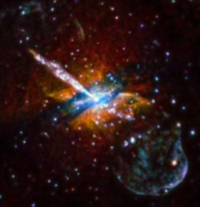 HEAPOW: Deep Into Cen A (2014 Feb 10)
HEAPOW: Deep Into Cen A (2014 Feb 10)
Centaurus A is one of the most famous radio galaxies known, generating enormous jets stretching over a million lightyears into intergalactic space. It is also a peculiar optical galaxy, an elliptical galaxy with a huge band of dark dust cutting the galaxy in half, and hiding the active nucleus of the galaxy. It's generally recognized now that Cen A is the result of a cosmic collision, in which a smaller, dust-rich spiral-type galaxy was swallowed by a massive elliptical galaxy. It's suspected that this collision drove enormous amounts of matter into the maw of a supermassive black hole, and as this energized material spirals into the black hole, some of it spirals off the disk and forms the radio- and X-ray emitting jets seen today on either side of the galaxy. X-ray observations provide a unique view of the high-energy processes in Cen-A, and can penetrate large amounts of the dust too, providing a unique view of what's going on in this strange galaxy. The image above is the best X-ray image of Cen-A yet obtained, a nearly 10-day exposure obtained by the Chandra X-ray Observatory. In this Chandra image, low energy (or "soft") X-rays are shown in red, medium-energy X-rays are green, and the highest-energy ("hard") X-rays are in blue. The dark strip of dust near the center shows in the Chandra image as a blue patch, since only the hard X-rays can penetrate through the nuclear dust. The spectacular jet of energetic outflowing material is clearly seen pointing from the middle of the galaxy to the upper left in the image. This deep observation allows astronomers to take the most detailed census of the X-ray emitting sources in Cen-A, and in particular has shown that bright X-ray emitting sources typically fall into two groups: neutron stars with masses less than twice the mass of the sun, or black hole X-ray binaries with masses more than five times the mass of the sun. The existence of this X-ray source "mass gap" may provide important clues about the way in which massive stars explode.
Chandra: Centaurus A: A New Look at an Old Friend
Spectral Properties of X-ray Binaries in Centaurus A - Mark J. Burke et al
- Astrophysical Journal 766(2) 88 (2013 Apr 01) DOI: 10.1088/0004-637X/766/2/88
arXiv.org > astro-ph > arXiv:1302.0851 > 04Feb 2013
| << Previous HEAPOW | High Energy Astrophysics Picture of the Week | Next HEAPOW >> |